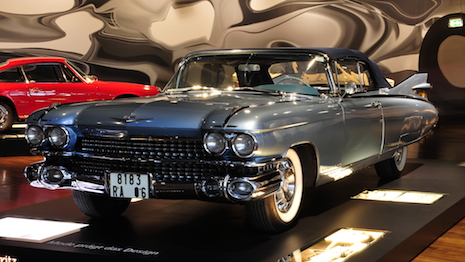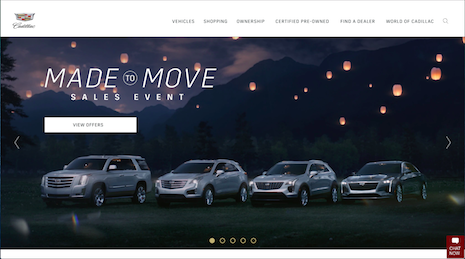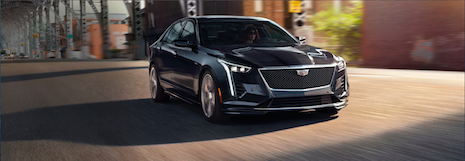 The 1959 Cadillac Eldorado Biarritz in all its glory at a German auto show. Image credit and copyright: Ralf Roletschek
The 1959 Cadillac Eldorado Biarritz in all its glory at a German auto show. Image credit and copyright: Ralf Roletschek
And here we go again: General Motors Co. goes public for the umpteenth time, wringing its hands, mea culpa and all, that its last iteration for Cadillac was wrong.
A recent article in the New York Times had the right amount of contrition and bemoaning from industry observers, critics and its newly appointed general manager: it did not keep up with competitors, the in-car tech rollout is slow, consumers are gravitating to SUVs and not sedans, its customer profile is aging, how it lags its German luxury auto peers and how wrong it was mid-decade to relocate the brand’s headquarters to New York’s trendy SoHo district.
Turnaround, reboot, comeback, do-or-die, last stand: these are words thrown around any Cadillac discussion – today or in the past couple of decades.
Now, GM is preparing to transition Cadillac to electric motors, smaller SUVs and sedans, hands-free steering and auto-piloting, and even that will lag competitors such as Tesla and BMW by years.
The one thing that seems to be going right for Cadillac is its range of bulky SUVs, the larger ones being the ride of choice for fleets, shared-ride services and Uber. The smaller SUVs, we are told, are attracting first-time buyers to the Cadillac brand. So there, the brand is doing something right.
Or not.
Sputter mutter
GM – and media, to a large extent – has bought all of the apologia and arguments for Cadillac’s stall. But they steadfastly refuse to acknowledge the true nature of what it means to be a luxury brand – if Cadillac is at all to be considered one anymore.
What is luxury? That is a question even successful luxury marketers struggle to answer in a consumer environment of short-term commitments and weakening loyalty to brands. Digitally savvy younger affluent consumers – and even the older baby boomers in a mood to divest themselves of stuff – want to experience luxury, but not own it.
But it is universally acknowledged that a luxury product has to be a thing of beauty, of quality, innovative in its application, backed by a splendid story and kind of limited in its distribution. The process of selling that luxury product has to leave an indelible impression in the consumer’s mind and be the ne plus ultra of customer service.
Similarly, with luxury services: all of the above, plus the memory of beyond-the-pale delivery, anticipatory attitude and flawless execution.
Translate some of those qualities to a car. Not just just any car, but Cadillac. How many of them apply?
 Can they move? Cadillac product line-up on the brand's Web site. Image credit: Cadillac
Can they move? Cadillac product line-up on the brand's Web site. Image credit: Cadillac
To nostalgic boomers, 1950s and '60s’ Cadillacs bring to mind chrome and fins, dual-tone paint and interior fabric, glamorous convertibles and soft suspensions for pampering rides. Advertising and good dealer service sealed the deal.
Come the '70s and the memories swap for hulking beasts and boxy designs unfit for a gas-strapped, inflation-ridden U.S. economy. Nothing to report from the 1980s, '90s and the noughts till the Cadillac Escalade SUV caught the imagination and fancy of a new cohort of customers.
The past two decades have seen Cadillac doing a search in the dark for its identity and what it stands for: the ride for aging pensioners in Florida, fleet owners’ choice of SUV wheels for its cavernous interiors or the car for millennials in thrall of sharp lines in headlamps, grilles, fenders and severe body line?
Missing from all this discussion is what made Cadillac famous in the first place: a fabulous, most comfortable ride with powerful engines and the latest technology in a most exquisitely designed vehicle.
One word can that is stubbornly missing from any Cadillac discussion: design.
Shape of things
Consumers shop first with the eyes and then buy with the mind.
Set aside its SUV line-up. What is Cadillac’s external and internal design appeal for its sedans? With due respect to its hardworking designers and engineers, it is not a patch on what it considers are its immediate competitors: Mercedes-Benz, BMW and Audi.
What makes these German cars, and others such as Jaguar, stand out? Beautiful bodies, rounded curves, instantly recognizable grilles that do not change by the decade but gently evolve.
What else? The satisfying sound of those cars’ doors opening or closing, the ease of entry and exit, plush interiors that are supple to the touch, elegant facia, nothing plasticky and an overall sense of luxury both for the driver and the driven.
Not only is their façade elegant to look at, but there is much to admire for their trunk’s elegance – gently rounded curves and softly-shaped lamps that speak a visual language of taste and grace.
Each one of those cars has a properly defined range of models to suit every need, from self-driven to sporty to chauffeur in front.
 The 2019 Cadillac CT6 sedan, sold out for this year and potentially tapped out for next. Image credit: Cadillac
The 2019 Cadillac CT6 sedan, sold out for this year and potentially tapped out for next. Image credit: Cadillac
Stand a Cadillac in front of these peers and it is instantly obvious. The CT6 – soon to be discontinued, per the NYT article – is diminutive and lacks the gravitas. The lower-end Cadillac sedans do not even match up to the similarly ranked Jaguars, Audis, BMWs and Mercedes’.
Detroit, we have a problem.
Cadillac’s design is uninspiring, unappealing and too sharp without the finesse. It is neither fish nor fowl, losing its appeal to older riders and not catching the fancy of younger affluents who prefer the story, look and performance of higher-end German and British luxury sedans.
GM should go back to the archives and issue some special-edition cars each year, dual-tone exteriors and interiors, spacious convertibles, chrome and great technology. Adapt to contemporary legal safety requirements in design. Bring back some old storied names such as the Eldorado, Series 62, Fleetwood, Biarritz and Park Avenue. Recapture the romance of driving a Cadillac.
See what works and then reintroduce some of these names to a new generation of consumers that seek quality and design, oomph and eco-friendly. Get rid of anonymous alphanumeric names, and stop imitating the Germans.
WITH ANY LUXURY CAR, all the way from the Rolls-Royce and Bentley to Mercedes-Benz, BMW, Maserati, Aston Martin and Jaguar, you are not buying a car – you are buying a dream and a companion to a lifestyle.
For Cadillac, a storied past is the key to a gloried future. It has the blueprint for success, all the way to the mid-1960s. Any mistakes it now makes is by design.
1958 television commercials for Cadillac
